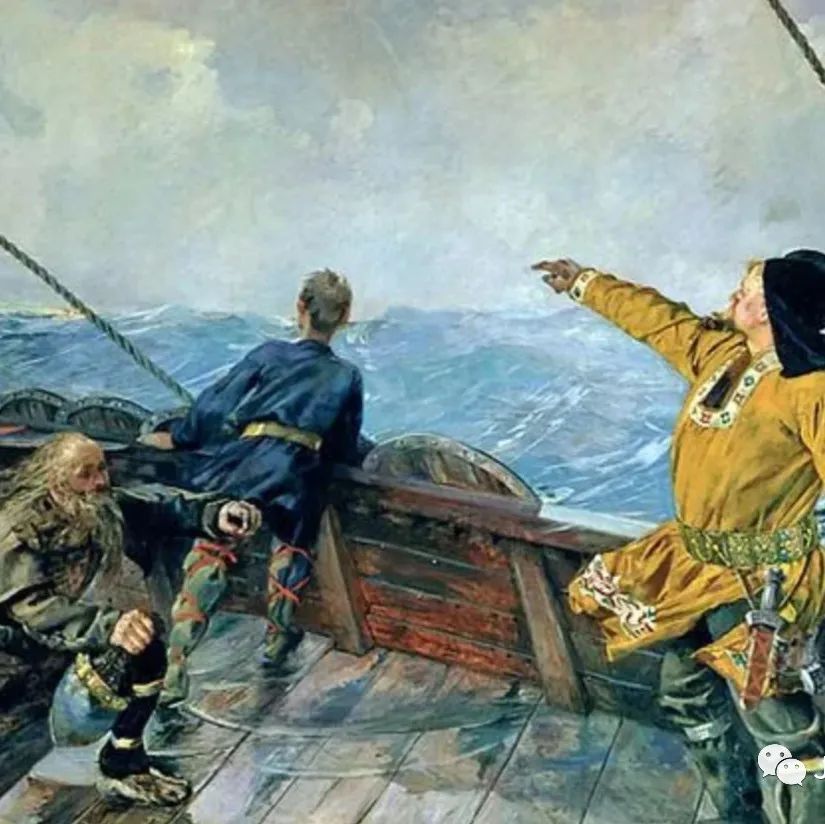Read History with Jack 42 - The Vikings Article 2 维京人2

In the last article, we examined the conquest history of the Vikings and their impacts on the politics, economics, and cultures of the modern-day Western hemisphere. But if one believes that the Vikings were only brutal seamen, pioneering political experimenters, or long-ranging traders, their understanding is incomplete. In this article, we will be looking at the fascinating exploration spirit of the Vikings. They were truly some of the greatest explorers throughout human history, and their explorations from Scandinavia to the further West, unbounded, are the most vivid evidence of their legendary age.
The Vikings' journeys to the West were some of the most brilliant ones in Western history. From the Scandinavian Peninsula, the Norwegian Vikings first reached Iceland in 861 C.E. According to the Icelandic sagas, the Viking Naddod deviated from his initial trip from Norway to the Faroe Islands due to strong winds. He eventually bumped into Iceland, naming the island "Snowland." Naddod returned to Norway and told his fellow Vikings about the discovery. In 867, another Norwegian Viking named Floki Vilgerdarson set out purposefully towards "Snowland" and became the first to set foot on the island. Vilgerdarson also gave the island its current name, "Iceland." In 870, people from the Scandinavian Peninsula, mainly Norway, moved and settled in Iceland. There was a significant increase in immigrants to Iceland in the 870s after the Viking chieftain Harald Fairhair brutally took control of Norway, causing many people to flee the region. The modern capital of Iceland, Reykjavik, was founded when another Norwegian chieftain, Ingolfur Arnarson, and family settled down on the southwest of the island in 874 in a place he called the "Cove of Smoke." The exploration and eventual settling of Iceland shows the irresistible curiosity of the Vikings to tap into unknown worlds and conquer them in the end with that exploratory mindset.
From Iceland, the Vikings still did not satisfy their curiosities. A belligerent yet courageous Viking, Erik the Red, was exiled from Iceland for three years in the 930s for murdering another man. Unlike others who were exiled, Erik the Red decided to sail west into the unknown, becoming the first Viking to discover Greenland, and he thoroughly explored the Southwest coast of it during his three years. When he was allowed to return to Iceland, he boasted about the good land he had found to the West. To attract more settlers, he gave the land the name "Greenland." Some of the Icelanders followed Erik the Red and settled on both the Eastern and Western sides of the island. Although the climate was unsuitable for large farming areas, the settlers managed to make a living by raising livestock and survived until the 14th century, when climate change made the area unfit for survival. The case with Greenland, just like with Iceland, displays the open, exploratory, and courageous mindsets of the Vikings.

A Viking trader Bjarni Herjolfsson was sailing to Greenland. But he was blown off to the West by strong winds. Herjolfsson decided to continue sailing west, and a few days later, sighted land. He managed to get back to Greeland, and he told Leif Ericsson, the son of Erik the Red, about his sightings of land to the West of Greenland. Without hesitation, Leif Ericsson led a group of men searching for this new land at around 1000 C.E. Ericsson and his crew sailed over 1800 miles of the open sea. They indeed bumped into the land that Herjolfsson was describing. The Greenland Vikings at least created a small settlement in modern-day Newfoundland, Canada, and named it Vinland, for the place had abundant sources of wine. But possibly due to hostile natives and other reasons, the settlement did not last long. The Vikings predated Columbus by around 500 years in discovering the Americas. Their journey was truly one of bravery, of curiosity into the unknown.
One of the Vikings' most glorious and intriguing characteristics is their exploration spirit. They were the first to probe into the unknown actively and possess a mindset determined to conquer the unknown. With this open, undaunted mindset, the Vikings expanded both West and East massively and constituted a legendary age marked with conquest, destruction and reconstruction, and cultural mingling. This mindset in a period of darkness, chaos, or uncertainty was truly what caused their success in bringing long-term impacts on the Western world. This mindset has become increasingly valuable as the modern age has turned more convoluted. Humankind must unleash themselves from the shackles of outdated paradigms and ways of thinking, and actively discover or embrace the unknown, just like the Vikings hundreds upon thousands of years ago.
WORKS CITED
Brownworth, Lars. The Sea Wolves: A History of the Vikings. United Kingdom, Crux
Publishing, 2014.
PICTURES CITED
http://www.webexhibits.org/vinland/archeological.html
https://www.historyonthenet.com/viking-explorations-and-settlements-iceland-greenland-and-vinland#:~:text=%20Viking%20Explorations%20and%20Settlements%3A%20Iceland%2C%20Greenland%20and,A%20trader%20named%20Bjarni%20Herjolfsson%20was...%20More%20

在上一篇文章中,我们研究了维京人的征服历史和他们对现代西方世界的政治、经济、文化等方面的深远影响。若一个人把维京人仅仅理解成残酷的海民、先锋的政治实验者,或长途跋涉的商人,那是对维京人身份的一个不完整的认知。在这篇文章中,我们将重点探讨维京人那难以置信的探索精神。他们确实是整个人类历史上最伟大的探险家之一,他们从斯堪的纳维亚向西的无限探索,是构成他们传奇时代的最生动的证据。
维京人向西方的旅程是西方历史上最辉煌的旅程。从斯堪的纳维亚半岛出发,挪威维京人于公元861年首次到达冰岛。根据冰岛的传奇故事记载,由于强风,维京人Naddod偏离了他最初从挪威到法罗群岛的行程。他最终撞上了冰岛,并将该岛命名为 "雪国"(Snowland)。Naddod回到了挪威,并将这一发现告诉了他的维京人同伴。867年,另一位名叫Floki Vilgerdarson的挪威维京人有目的地向 "雪国 "出发,成为第一个踏上该岛的人。Vilgerdarson还为该岛起了其现代名称,即 "冰岛"。870年,来自斯堪的纳维亚半岛的人们,主要是挪威人,开始向冰岛迁移并定居。九世纪70年代,在维京酋长Harald Fairhair残酷地开始统治挪威后,许多人决定逃离该地区,因此移民到冰岛的人数大增。冰岛的现代首都雷克雅未克是在另一位挪威酋长Ingolfur Arnarson与家人一起于874年在该岛西南部在一个他称之为 "烟湾 "的地方定居下来后建立的。对冰岛的探索和最终定居表明,维京人对挖掘未知世界有着不可抗拒的好奇心,并最终以这种探索的心态征服了这些世界。
从冰岛出发,维京人仍然没有满足他们的好奇心。Erik the Red,一个好战而勇敢的维京人,在930年代因谋杀他人而被放逐出冰岛三年之久。与其他被流放的人非常不同的是,Erik决定向西航行,进入未知的世界。他成为第一个发现格陵兰岛的维京人,他在三年时间里彻底探索了格陵兰岛的西南海岸。当他返回冰岛时,他夸耀了他在西部发现的好土地。为了吸引更多的定居者,他给这片土地取名为 "格陵兰"(Greenland),或“绿色的土地”。一些冰岛人跟随Erik,在岛屿的东部和西部定居。虽然气候不适合大面积耕种,但定居者还是通过饲养牲畜来谋生,并一直生存到14世纪,直到气候变化使该地区不适合生存。格陵兰岛的情况,就像冰岛一样,显示了维京人开放、探索和勇敢的心态。

一位维京人商人Bjarni Herjolfsson正在向格陵兰岛航行。但他被强风吹到了西方。Herjolfsson决定继续向西航行,几天后看到了陆地。他设法回到了格陵兰岛,并把他在格陵兰岛西部看到陆地的情况告诉了Erik the Red的儿子Leif Ericsson。于是,公元1000年左右,Ericsson毫不犹豫地带领一群人去寻找这片新的土地。Ericsson和他的船员航行了1800多英里,他们最终确实看见了Herjolfsson所描述的土地。格陵兰维京人至少在今天的加拿大纽芬兰创建了一个小定居点,并将其命名为Vinland,因为这个地方有丰富的葡萄酒来源。但可能是由于当地人的敌意和其他原因,这个定居点没有持续很久。维京人发现美洲的时间比哥伦布早了大约500年。他们的旅程确实是勇敢的,是对未知世界的毫无阻挡地探索。
维京人最光荣和耐人寻味的特点之一就是他们的探索精神。他们是第一个积极探索未知世界的人,拥有一种决心征服未知世界的心态。正是凭借这种开放、不畏艰险的心态,维京人成功地在西方和东方大规模扩张,并构成了一个以征服、破坏和重建以及文化交融为特征的传奇时代。在一个黑暗、混乱或不确定的年代,这种心态导致了他们能有效给西方世界带来长期影响。随着现代世界变得愈发复杂,这种心态变得越来越有价值。人类必须从过时、老套的思维方式的桎梏中解脱出来,像维京人一般积极发现和拥抱未知。
- 本文标签: 原创
- 本文链接: http://www.jack-utopia.cn//article/419
- 版权声明: 本文由Jack原创发布,转载请遵循《署名-非商业性使用-相同方式共享 4.0 国际 (CC BY-NC-SA 4.0)》许可协议授权










